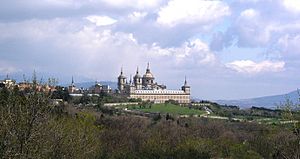Juan Bautista de Toledo facts for kids
Juan Bautista de Toledo (born around 1515 – died May 19, 1567) was an important Spanish architect. He learned his skills in Italy, studying the amazing Italian High Renaissance style. Like many architects of his time, he was good at both designing buildings and working on big public projects, like roads and forts. He was born in either Toledo or Madrid, Spain, around 1515. He passed away in Madrid on May 19, 1567.
Contents
His Career and Famous Projects
Early Work in Italy
Juan Bautista de Toledo might have started his architecture career in Rome between 1534 and 1541. He possibly worked for famous artists like Michelangelo and Pope Paul III. He may have helped finish the courtyard of the Palazzo Farnese. Another idea is that he continued his training at the construction site of St. Peter’s Basilica in Rome. He might have worked there under the direction of Antonio da Sangallo the Younger.
Juan Bautista de Toledo was a bit of a mystery. In Florence and Rome, he was known as Giovanni Battista de Alfonsis. However, in Naples and Madrid, people knew him as Juan Bautista de Toledo. It's thought that both names belonged to the same person, perhaps his full name was Juan Bautista de Toledo Alfonsis.
Working for the Pope
On December 18, 1546, Pope Paul III chose Juan Bautista, a Spaniard, to be a Deputy Coordinator Architect for St. Peter's Basilica in Rome. Later, in February 1547, Michelangelo told a master builder to follow the orders of Giovanni Battista de Alfonsis. Michelangelo had personally chosen him for this important role.
Projects in Naples
Before Pope Paul III, his supporter, died in 1549, Juan Bautista de Toledo moved to Naples. This happened in September 1548, after he was called by the Viceroy Pedro Álvarez de Toledo. In Naples, he worked as the "Maestro Mayor de Obras Reales," which means "Master of Royal Works in the Kingdom of Naples."
In Naples, he designed and rebuilt many buildings. These included the Strada di Toledo (now called Strada di Roma) and the church of St. Giacomo degli Spagnuoli. He also designed square forts for the Castello Nuovo and a large palace at Posillipo. He worked on the fortress of Sant'Elmo and several fountains.
Return to Spain and Royal Architect
In 1559, Philip II called Juan Bautista de Toledo back to Spain. He was appointed "Maestro Mayor de Obras Reales," mainly working in Madrid and Toledo. At first, his yearly pay was not very high. This was because King Philip liked to test the abilities of his Spanish artists before giving them larger salaries.
He helped restore important buildings like the Alcazar de Madrid and the Alcazar of Toledo. He also worked on the Convento de los Jerónimos de Madrid. He designed the front of the church of Las Descalzas Reales. He also did architectural and public works at the Casa de Campo in Madrid, Casa Real de Aceca, and the Palacio de Aranjuez.
El Escorial: His Masterpiece

In 1561, Juan Bautista de Toledo was chosen as the "Arquitecto Real" (Royal Architect). He was put in charge of planning the entire area around El Escorial. This included the Monastery, the village of El Escorial, and La Granjilla. This whole area, known as "El Escurial" in the 16th century, is now a UNESCO World Heritage Site.
His most important job was at El Escorial. On April 23, 1563, during the ceremony to lay the first stone, Juan de Herrera wrote on it: "JOANNES BAPTISTA ARCHITECTUS MAJOR. APRILES 23". This means "Juan Bautista, Major Architect. April 23." This showed how important he was to the project.
Juan Bautista de Toledo oversaw the building and public works in El Escorial village and around the El Escorial Monastery. He also worked on La Granjilla de La Fresneda until he died in 1567. The Monastery was later finished by Juan de Herrera in 1584.
The main public works in the El Escorial area included the Aqueduct and Ponds of La Granjilla. There was also an Aqueduct to the Monastery and two streets connecting El Escorial village to the Monastery and La Granjilla. The design of El Escorial by Juan Bautista de Toledo and Juan de Herrera is a great example of how a whole area can be developed with beautiful and important designs.
He also designed the overall plan for La Granjilla de La Fresneda. Other architects like Gaspar de Vega and Juan de Herrera helped finish this project. A gardener named fray Marcos de Cardona and Dutch dam experts, Petre Janson and Spond, also helped.
See also
 In Spanish: Juan Bautista de Toledo para niños
In Spanish: Juan Bautista de Toledo para niños


